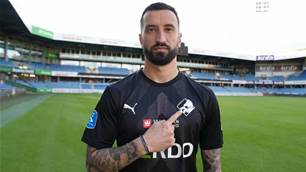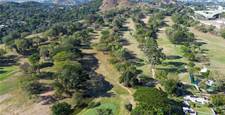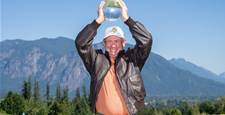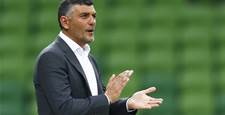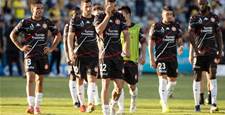DIZZY highs, miserable lows and landmark changes. Here are our top 50 moments, in no particular order, that shaped and defined Australian football as we know it today
Australia reaches FIFA rankings high
While some thumb their nose at idea of the FIFA World Rankings, they play a major role in the global perception of football nations - an area where the Socceroos have been grossly underestimated in previous years.
The football pitch decides head-to-head battles, but the rankings are a well devised guide to progress over a period of time.
An all-time low of 92 was hit in 2000, while September of this year witnessed the Socceroos reach nose bleed territory with an all-time high of 14.
More established countries scoffed at Australia's lofty position, however there is no cheating the system.
After Australia's most convincing World Cup qualification ever and a series of impressive friendly victories, we found ourselves above the likes of Portugal, Czech Republic and Mexico.
With a World Cup host bid gathering pace, the men with the votes will need to see Australia's worth on the pitch and the dizzying ranking will no doubt help the cause.
Socceroos reach 1997 Confeds Cup final
The dust had barely settled on the Socceroos' Iran heartbreak when Terry Venables' men had to get up for the Confederations Cup in Saudi Arabia.
It was fascinating to see how the 'Roos would react barely three weeks after the devastating exit. It was either going to be an utter disaster or a surprise success. Fortunately it was the latter.
While the final was a 6-0 whitewash to Brazil over a ten-man Socceroos, who had Viduka sent off after 24 minutes, the rest of the tournament proved an eye-opener.
The semi against Uruguay cemented teenager Harry Kewell's growing status as a rising star with a cracking strike to win the tie. Earlier in the tournament, a classy 3-1 win over Mexico helped by a brilliant long-range effort from Joe Skoko and a 0-0 draw with Brazil - who seven months later made the World Cup final - emphasised what we could've achieved at France 98.
Jason Culina return sends positive message
For the first four seasons of the A-League there were three categories of Australian players: youngsters learning their trade; players at their peak but not quite good enough for overseas success; and old hands playing out their final days.
Jason Culina changed all that. When he inked his deal for marquee status at new franchise Gold Coast United, he broke the mould of previous A-League pigeon holes; he was a current Socceroo playing at a high level in Europe and returning to the A-League in his pomp.
It sent a message to all other Socceroos that the A-League doesn't have to be just your kindergarten, middle-ground or graveyard, it can be your first choice, too. Pim Verbeek did not approve of the move, but Culina didn't not listen to his coach. Despite this, Culina has remained in the Dutchman's plans since.
Let's hope the midfielder has started a trend for other Socceroos to follow suit in the future.
Australia enters FIFA
Australia's entry into FIFA in 1963 afforded the national team a chance to play for a place at a World Cup finals. Until then, Australia played an assorted mix of club or regional sides in A and B internationals.
But with entry granted, FIFA World Cup qualifiers became the main focus, which in turn would ratify our credentials as a football nation.
It only gave us two years to prepare for the first FIFA qualifier test. Against North Korea in neutral Cambodia, the Aussies had to negotiate the heat and a very tricky opposition over two legs.
A 9-2 aggregate loss (6-1 and 3-1 losses) was a spiky introduction but also a harbinger of things to come for the under-rated North Korea at the 1966 World Cup in England.
Prior to 1963, Australia was a blip on the world football map at best. The FIFA stamp gave us credibility and offered us the biggest stage - a stage we've since qualified for three times.
Birth of summer football1989
The arrival of football as a 'summer' sport 20 years ago was in response to the Australian sport's evolving landscape.
Clearly, football's rival codes rugby league and Aussie rules were fast becoming darlings of the media and powering on with their own national expansionary vision (the Broncos in the NRL and West Coast and Brisbane Bears in the AFL).
What it also allowed was an aligning of seasons between Europe and Australia - meaning players could in theory trial in the off-season without leaving their NSL clubs at vital times.
Playing surfaces was another major benefit. As we've seen in the A-League, the first eight weeks of games at multi-use stadiums can be hazardous. Summer football was a response to that, kicking off the season in the first week of October. So soccer - as it was known then - sought a summer sanctuary to carve out its own niche.
We've settled into the idea of summer football now and we've been a summer club sport ever since.
Australian football's Dutch revolution
Dutch roots run deep within the FFA, from team coaches such as Guus Hiddink, Pim Verbeek, Henk Duut and Jan Versleijen, to the technical direction of the whole system in this country - first through Rob Baan and now Han Berger.
The success and universal likability of Guus Hiddink has made the work of his countrymen far more acceptable in Australian eyes.
While Aussies Graham Arnold and Ange Postecoglou were publically chastised for their efforts with Australia's youth sides, Jan Versleijen led the Young Socceroos to three consecutive defeats at the recent U20 World Cup and no one seemed to blink an eye. The Dutch respect is now ingrained.
While Pim Verbeek was not a popular choice at the time of his appointment (or arguably still), he has picked up where Guus left off by getting Australia to a second consecutive World Cup. True fans of the game appreciate what Verbeek has done.
The FFA's plans for the development of young players and future Socceroos teams is heavily invested in a Dutch approach.
The National Football Curriculum is a Dutch approach, a concept of 'Total Football', using flowing football and technical ability on the ball. It is a revered one around the world and, much like
many members of the Dutch football administration, is coming Down Under. TT
Five-star Archie makes Grand Final history
What Archie Thompson did against Adelaide United in the 2007 Grand Final is unlikely to ever be repeated. Finals are normally tense and tight affairs; in fact, they often disappoint.
Not that Adelaide fans weren't depressed by the end, but the majority of the 55,000 people on hand were joyous at the most spectacular of Victory victories. That sea of royal blue cheering on their marquee star's finest domestic hour sent a message to the rest of the country. Football was here and here to stay.
Records are made to broken, but as Archie bagged his fourth and fifth goals, there was a sense the former Socceroo's celebratory, tongue-out place in the history books might be permanent.
It was a finishing clinic of the highest order against one of the best defences in the league - albeit without midfielder Ross Aloisi who was sent off on 30 minutes when the game was still salvageable. Credit must also go to Brazilian Fred for setting up Archie for four of his goals, a man of the match performance on any other night.
Everything Archie tried worked on that humid night but it was the look of shock on his face as the goals continued to come that will be the enduring image.
Not that he should have been surprised. He admitted afterwards that he had dreamt midweek that he was going to score a hat-trick in the final - he was only two out...
Crawford report ends Soccer Australia
With the old NSL like a punch drunk boxer about to hit the canvas, something had to be done about Aussie soccer.
The Crawford Report - the Independent Soccer Review Committee into the Structure, Governance and Management of Soccer in Australia in April 2003 - was the beginning of the end of 'old soccer'.
It was unheard of to actually wind up a national body and declare it bankrupt. In truth, it was bankrupt of ideas too.
It was also hamstrung by some the myriad rules and regulations and the state/federal divisions. The report put a microscope over the "the existing governance, management and structure of soccer in Australia... to deliver a comprehensive governance framework and management structure for the sport that addresses the needs of affiliated organisations and stakeholders".
All corporate speak for cleaning up the byzantine structure of football and paving the way for a new direction to flourish under a reconstituted national body and framework.
"We believe that the adoption and implementation of this report's recommendations will provide the foundation for success in national development, financial stability, stakeholder and public support, and international performances that have, on a consistent basis, eluded the sport in the past," the report claimed. They were right.
Australia 2 Iran 2
Just say, "The Iran Game". Nothing else. No year, no specifics, no nothing.
It's seared into Aussie football consciousness like a death in the family. That stomach-churning, car-crash of a night at the MCG dangled World Cup qualification 25 years after Jimmy Mackay's heroics in Hong Kong. Then, like a horror movie unfolding, it was cruelly and painfully taken away.
For the record, a 1-1 draw away in Tehran set up the second leg against Iran at the MCG in the Socceroos' final qualifier for France 1998. The national anthem shook the foundations; there was a carnival, pre-match glow. The stadium a sea of green and gold.
Australia bombarded the battle hardened Iranians in a blistering first half, going one up through teenager Harry Kewell. A second half goal to Aurelio Vidmar had us dreaming of the Champs Elysee.
But we cocked it up in 20 god-forsaken, ugly minutes that still cuts deep. It was there for the taking, all we had to do was grab it. But we didn't. We couldn't. A break in play allowed the Iranians the time to figure out the situation. The Socceroos were tiring.
Terry Venables' 'Roos - unbeaten in their qualifiers - allowed Iran back in the game and they nicked a 2-2 draw with late goals to Khodadad Azizi and Karim Bagheri. "This is a great place for Iranian pleasure" beamed Azizi moments after the game.
Life can be painful; and for Socceroo fans in the 1990s, the pain and despair was becoming the
norm. Conversely, that night also showed how much support was out there for our national team. Sadly, it brutally exposed yet again the ability to shoot ourselves in the foot.
Craig Johnston scores in 1986 FA Cup Final
The 1980s was a decade when export of our talented players slowly gained pace; Krncevic, Farina, Slater, Mitchell and Arnold to name a few that made the trip. But with all respect to that group, none reached the heights of Craig Johnston.
But for all his success with Liverpool in England and in the European Cup, it was Johnston's goal in the 1986 FA Cup final against Everton that is the most recognised moment in his career.
The FA Cup was always a big day in the Australian sporting calendar - a night (because it would kick off at midnight) when non-football fans could revel in this annual occasion along with the die-hards.
So, given this, Johnston's goal was a particularly proud moment for football in Australia. It didn't matter that he'd already represented England U21s or his comments about playing for Australia (he's said to have stated that playing football for Australia was "like surfing for England").
Here was a kid, a complete unknown from the Hunter - once dubbed the worst footballer Boro boss Jack Charlton had ever seen - who'd done it tough and made it. He was to become a hero to Harry Kewell and the like.
And Johnston made it in the arguably the greatest ever Liverpool side, a Double-winning side featuring Dalglish, Rush, Mølby and Hansen. He showed us how far we can go with that Aussie grit. Sadly, he never played for Australia but that goal at Wembley proved an inspiration to an entire generation of Australian professionals.
Continued on next page
Related Articles

Socceroos midfielder embraces move to England
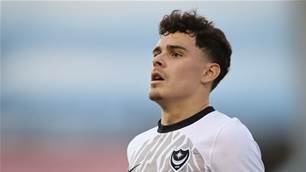
Cardiff City snap up sought-after Socceroos starlet
